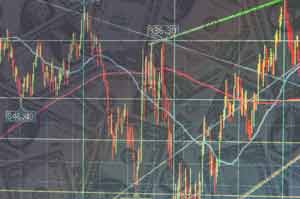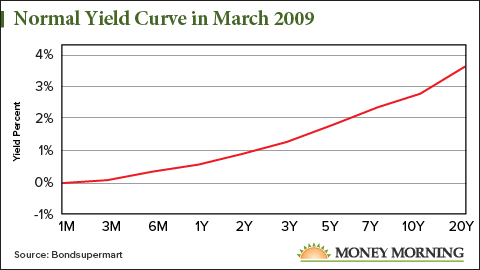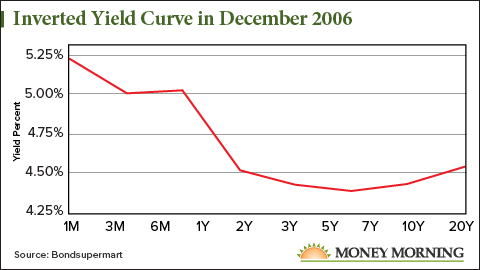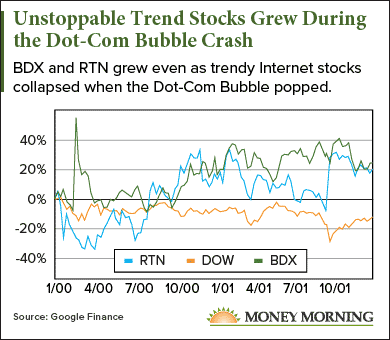A financial warning sign that preceded the last seven recessions is about to signal again, and that could mean a recession in 2018 is coming...
This event happened every single time before the recessions of 2007, 2001, 1990, 1981, 1980, 1973, and 1969.

It's considered one of the most reliable sources of recession predictions...
Bob Landry, the chief investment officer of USAA, calls this a "classic recession signal."
And this event could be just months away....
In fact, U.S. Federal Reserve policies could trigger it in 2018...
The "Classic Recession Signal" You Can't Afford to Miss
An "inverted yield curve" has happened before the last seven recessions, and the curve is nearing an inversion right now.
Now, an inverted yield curve might sound like Wall Street jargon or something out of an economics textbook. But it's actually straightforward and easy to see.
Urgent: Feds use obscure loophole to threaten retirees. If you have a 401(k), IRA, or any type of retirement account, this could cause you to miss out on $68,870 or more. Learn more...
The yield curve refers to the difference in bond yields between short-term and long-term bonds.
Since bonds pay a fixed interest rate, the yield is calculated by dividing the price of the bond by its interest payments. As bond prices fall, yields rise because you're paying less money for the same amount of interest. And yields fall as bond prices rise, since you're paying more money to collect the fixed interest payments.
Now, that's important, because investors - from average retail investors to giant hedge funds - buy up bonds when the economy is weak. You see, bonds are safe investments, and their fixed interest payments are attractive during times of economic stagnation.
Netting a 2% return on your bond investment is better than losing 20% in the stock market during a recession.
And that's why seeing the yield curve shift from "normal" to "inverted" is a recession warning sign...
When the yield curve is "normal," long-term Treasury bonds, like the 10-year and 30-year bonds, return a higher yield than short-term bonds, like the two-year or five-year bonds. When the economy is booming, long-term bonds are in less demand, so their yields are higher.
Check out the normal yield curve from March 2009, right at the start of the current bull market...

But when the yield curve "inverts," short-term bond yields rise above long-term bond yields. That's because money is being moved into the safe, long-term bonds, driving their prices higher and their yields lower.
Here's the inverted yield curve from December 2006, one year before the Great Recession...

You see, the yield curve "inverts" when investors seek out safe-haven assets, because a poor economy makes it too risky to invest in stocks.
And where investors move their money is a better sign of economic health - and a predictor of a coming recession - than any amount of guesswork by the media or the government.
Right now, the yield curve is flattening. Check out how it has flattened over the last year alone...

That means an inverted yield curve is a serious possibility in 2018, and the Fed could be the cause...
How the Fed Can Invert the Yield Curve
The Fed itself is predicting there will be four more interest rate hikes by the end of 2018, and it is planning to unwind its massive $4.5 trillion balance sheet.
This tightening of monetary policy, especially through higher interest rates, could invert the yield curve.
When the Fed raises rates, newly issued Treasury bonds will pay a higher interest rate than older bonds. That sends short-term yields up, helping invert the curve.
In fact, that's exactly what happened in 2006, when then-Fed Chair Alan Greenspan hiked rates 400 basis points. Short-term yields rose more than long-term yields, inverting the curve.
Now, a bump to short-term yields itself isn't what causes a recession.
But the Fed hiking interest rates alongside increasingly pessimistic investors is a serious warning sign for the next recession.
Fortunately, investors can protect themselves from the worst of a recession. And they can do it without fleeing the stock market for overpriced bonds.
In reality, you can protect your money, and even profit, even if the stock market tumbles...
How to Protect Your Money from a Recession in 2018
[mmpazkzone name="in-story" network="9794" site="307044" id="137008" type="4"]
While investors might want to flee stocks during recessions, that's a mistake. And while stock indexes might decline during a recession, there are ways to profit from stocks during downturns.
It's simply a matter of owning the right stocks...
The trick to making huge profits is to find "must-have" companies that fall into what Money Morning Chief Investment Strategist Keith Fitz-Gerald calls the six "Unstoppable Trends": medicine, technology, demographics, scarcity/allocation, energy, and war, terrorism, and ugliness (also known as "defense"). The Unstoppable Trends are backed by trillions of dollars that Washington cannot derail, the Fed cannot meddle with, and Wall Street cannot hijack.
Fitz-Gerald recommends Raytheon Co. (NYSE: RTN) and Becton, Dickinson and Co. (NYSE: BDX).
Not only are these stocks resilient during downturns because they are in demand, but they both have double-digit price targets over the next year...
Raytheon Co. (NYSE: RTN) is a leader in the Unstoppable Trend of war, terrorism, and ugliness.

As one of the top five largest defense contractors in the world, Raytheon has billions in contracts with the U.S. government and governments worldwide. International customers make up half of Raytheon's portfolio. And because defense is a global necessity whether the stock market is up or down, Raytheon will always be in demand.
For example, as tensions rise abroad, the United States is more likely to need more weapons and equipment. When the United States launched a missile strike on a Syrian airbase on April 7, Raytheon's stock jumped more than 2%, since its missiles were used.
RTN currently trades at $189.15 a share and pays a 1.69% dividend yield. RTN is up 33% this year, and Wall Street analysts are giving it one-year price targets as high as $225. That could bring owners a 19% gain.
Becton, Dickinson and Co. (NYSE: BDX) is our best play for the Unstoppable Trend of demographics.
BDX is a healthcare company specializing in single-usage medical products utilized in hospitals and long-term care facilities.
But what makes this an Unstoppable Trend is an aging demographic in the United States. As the population gets older, more people will need medical care, especially long-term care. And because people need healthcare no matter what the stock market is doing, BDX's demand will continue to grow.
BDX is also an exceptionally well-managed company, which means it's turning that demand into profits for its investors.
Becton Dickinson has a 10.54% profit margin, even after a $12.2 billion takeover of CareFusion two years ago. That means the company's capital management is sustainable and will easily survive a market downturn. But most importantly, BDX transfers those profits to shareholders through its 1.33% dividend yield and growing share price.
BDX trades at $225.96 and is up 36.5% on the year. Wall Street analysts set one-year price targets for BDX as high as $260, a 15% jump.
An $80 Billion Cover-Up? Under the watchful eye of Congress, the government will soon be implementing a controversial plan that threatens the retirement of millions of Americans. And they're using an obscure loophole buried in Title 29 of the U.S. Labor Code to do it. If you have a 401(k), IRA, or any type of retirement account, this could cause you to miss out on $68,870 or more. Learn more...
Follow Money Morning on Twitter @moneymorning, Facebook, and LinkedIn.


